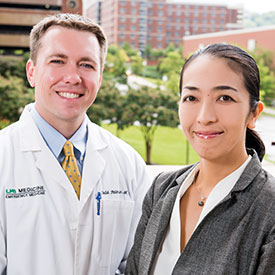 As a Learning Communities faculty mentor, Todd Peterson (left) leads small group discusions about medical ethics. Mariko Nakano (right), assistant professor of bioethics, created much of the school’s new medical ethics curriculum. At the intersection of medicine and morality lies medical ethics, a system of principles that guides how physicians apply values and judgments to their practice. But determining the best way to teach medical ethics can be tricky. In the last few years, the School of Medicine realized that holding occasional ethics teaching sessions with an entire 180-person class wasn’t conducive to meaningful dialogue. Aside from those large group discussions, it has traditionally been left to faculty members to incorporate ethics lessons into the regular curriculum.
As a Learning Communities faculty mentor, Todd Peterson (left) leads small group discusions about medical ethics. Mariko Nakano (right), assistant professor of bioethics, created much of the school’s new medical ethics curriculum. At the intersection of medicine and morality lies medical ethics, a system of principles that guides how physicians apply values and judgments to their practice. But determining the best way to teach medical ethics can be tricky. In the last few years, the School of Medicine realized that holding occasional ethics teaching sessions with an entire 180-person class wasn’t conducive to meaningful dialogue. Aside from those large group discussions, it has traditionally been left to faculty members to incorporate ethics lessons into the regular curriculum.
Now, ethics and other topics are being taught in small groups called Learning Communities. On the first day of medical school, students are assigned to a Learning Community comprised of about 18 students from all classes. “The main purpose of a Learning Community is to provide a safe, comfortable environment where a student can thrive for four years,” says faculty mentor Todd B. Peterson, M.D., associate professor of emergency medicine. The Learning Communities model also offers a better way to address topics like ethics, service learning, stress management, and others, Peterson says.
Moving ethics training to the Learning Communities wasn’t done just to make students feel more comfortable; the old method also wasn’t optimal for test preparation, says Mariko Nakano, Ph.D., assistant professor of medical education and creator of much of the new ethics curriculum. To better prepare students for questions they might encounter on the United States Medical Licensing Examinations, Nakano created short, animated videos that students can watch online as often as they like. The videos cover issues such as patient consent, privacy, and end-of-life decisions. But the point of the ethics training changes goes beyond test preparation, she says.
“It’s important to learn a code of ethics so future physicians can know what they should do and act on the spot,” Nakano says. “We don’t want our students to become heartless calculators of the consequences—they need to have time to reflect on their own ethical values and their own attitudes toward life and death and suffering. Those kinds of issues are very hard to deal with in a large class.”
 Some ethical questions are timeless, and some change with the times, such as issues surrounding social media ethics and professionalism online. “With social media, you can’t control your audience so you have to be extra careful,” Peterson says. Seemingly innocent photos taken in the hospital might include private information in the background, such as a patient’s name and room number. One scenario presented in the training involves a physician’s social media post about a broad topic—the use of restraints—that was inspired by a recent patient’s case. While the post might not name the patient, physicians need to be aware that the patient’s family and the hospital staff can probably figure out which patient inspired the post.
Some ethical questions are timeless, and some change with the times, such as issues surrounding social media ethics and professionalism online. “With social media, you can’t control your audience so you have to be extra careful,” Peterson says. Seemingly innocent photos taken in the hospital might include private information in the background, such as a patient’s name and room number. One scenario presented in the training involves a physician’s social media post about a broad topic—the use of restraints—that was inspired by a recent patient’s case. While the post might not name the patient, physicians need to be aware that the patient’s family and the hospital staff can probably figure out which patient inspired the post.
Cody Meyers, a third-year medical student who has experienced the old method of ethics training and the new Learning Communities model says that the old way often ended up like political discussions, with a few people with strong, polarized opinions voicing them loudly and people who wanted to discuss gray areas staying out of the fray.
“It wasn’t productive, and many people wouldn’t participate at all,” Meyers says. “Now, there’s more room for middle ground and people feel comfortable speaking up.” Meyers says he’s looking forward to having more genuine discussions with his peers on issues like palliative care. “As it continues to evolve and grow, I think this type of ethics training is going to be really good for the future generations of medical students.”
By Tara Hulen